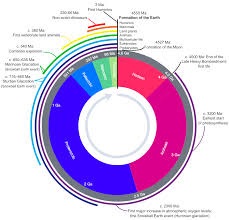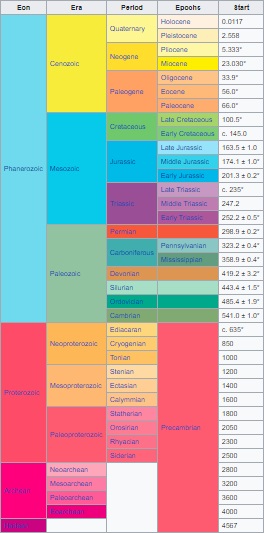|
|
| |
|
|
| |
|
|
|
|
| |
 |
| Geological time in a
diagram called a geological clock, showing the
relative lengths of the eons and eras of the
Earth's history. |
Historical Geology
Historical geology uses the principles and techniques of
geology to work out the geological history of the Earth.
It looks at the processes which change the Earth's
surface and rocks under the surface.
Geologists use stratigraphy and paleontology to find out
the sequence of the events, and show the plants and
animals which lived at different times in the past. They
worked out the sequence of rock layers. Then the
discovery of radioactivity and the invention of
radiometric dating techniques gave a way to get the ages
of the layers (strata).
We now know the timing of important events that have
happened during the history of Earth. The Earth is about
4.567 billion (4,567 million) years old. The geological
or deep time of Earth's past has been organized into
various units. Boundaries on the time scale are usually
marked by major geological or palaeontological events,
such as mass extinctions. For example, the boundary
between the Cretaceous period and the Palaeogene period
is defined by the Cretaceous–Tertiary extinction event.
This marked the end of the dinosaurs and of many marine
species.
Prospecting for energy sources and valuable minerals
depends on understanding the geological history of an
area. Such knowledge can also help lessen the hazards of
earthquakes and volcanoes. |
|
 |
| The geological time
scale. |
Terminology
The largest defined unit of time is the supereon
composed of Eons. Eons are divided into Eras, which are
in turn divided into Periods, Epochs and Stages. At the
same time paleontologists define a system of faunal
stages, of varying lengths, based on the kinds of animal
fossils found there. In many cases, such faunal stages
have been adopted in building the geological
nomenclature, though in general there are far more
recognized faunal stages than defined geological time
units.
Geologists tend to talk in terms of Upper/Late,
Lower/Early and Middle parts of periods and other units,
such as "Upper Jurassic", and "Middle Cambrian". Upper,
Middle, and Lower are terms applied to the rocks
themselves, as in "Upper Jurassic sandstone," while
Late, Middle, and Early are applied to time, as in
"Early Jurassic deposition" or "fossils of Early
Jurassic age." The adjectives are capitalized when the
subdivision is formally recognized, and lower case when
not; thus "early Miocene" but "Early Jurassic."
Because geologic units occurring at the same time but
from different parts of the world can often look
different and contain different fossils, there are many
examples where the same period was historically given
different names in different locales. For example, in
North America the Lower Cambrian is called the Waucoban
series that is then subdivided into zones based on
trilobites. The same timespan is split into Tommotian,
Atdabanian and Botomian stages in East Asia and Siberia.
A key aspect of the work of the International Commission
on Stratigraphy is to reconcile this conflicting
terminology and define universal horizons (time
division) that can be used around the world. |
|
Historical development
Nicolaus Steno, also known as Niels Stensen, was the
first to observe and propose some of the basic concepts
of historical geology, called the "father of geology".
One of these concepts was that fossils originally came
from living organisms. The other, more famous,
observations are often grouped together to form the laws
of stratigraphy.
James Hutton and Charles Lyell also contributed to early
understanding of the Earth's history with their
observations at Edinburgh in Scotland concerning angular
unconformity in a rock face and it was in fact Lyell
that influenced Charles Darwin greatly in his theory of
evolution by speculating that the present is the key to
the past. Hutton first proposed the theory of
uniformitarianism, which is now a basic principle in all
branches of geology. Hutton also supported the idea that
the Earth was very old as opposed to the prevailing
concept of the time which said the Earth had only been
around a few millennia. Uniformitarianism describes an
Earth created by the same natural phenomena that are at
work today.
The prevailing concept of the 18th century in the West
was that of a very small age of the Earth, dominated by
catastrophic events. This view was strongly supported by
adherents of Abrahamic religions based on a largely
literal interpretation of their religious scriptural
passages. The concept of uniformitarianism met with
considerable resistance and the catastrophism vs.
gradualism debate of the 19th century resulted. A
variety of discoveries in the 20th century provided
ample evidence that Earth history is a product of both
gradual incremental processes and sudden cataclysmic
events. Violent events such as meteorite impacts and
large volcanic explosions do shape the Earth's surface
along with gradual processes such as weathering, erosion
and deposition much as they have throughout Earth
history. The present is the key to the past - includes
catastrophic as well as gradual processes. |
|
|
|
|
|
|
|
|
|
|
|
|
|
|
|
|
|
|
Search Fun Easy English |
|
|
|
|
|
|
|
|
|
|
|
|
|
|
|
About
Contact
Copyright
Resources
Site Map |